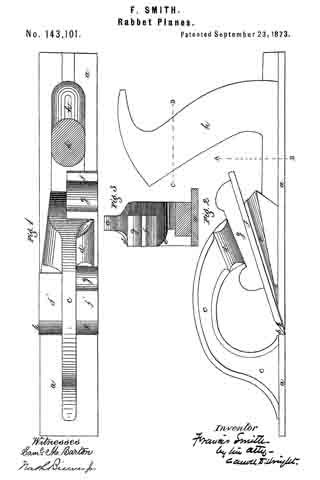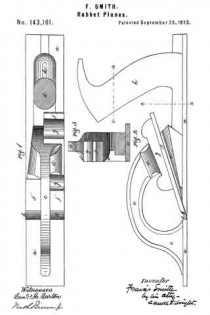
| PLEASE NOTE: The images presented on this page are of low resolution and, as a result, will not print out very well. If you wish to have higher resolution files then you may purchase them for only $2.95 per patent by using the "Buy Now" button below. All purchases are via PayPal. These files have all been cleaned up and digitally enhanced and are therefore suitable for printing, publication or framing. Each zip package contains all the images below (some packages may contain more), and purchased files can be downloaded immediately. |
UNITED STATES PATENT OFFICE.
_________________
FRANCIS SMITH, OF BOSTON, ASSIGNOR TO JOHN SULLY,
TRUSTEE, OF DEDHAM, MASSACHUSETTS.
IMPROVEMENT IN RABBET-PLANES.
_________________
Specification forming part of Letters Patent No. 143,101, dated September 23, 1873; application filed May 28, 1873.
_________________
To all whom it may concern:
Be it known that I, FRANCIS SMITH, of Boston, in the county of Suffolk and State of Massachusetts, have invented certain Improvements in Rabbet-Planes, of which the following is a specification:
Figure 1 of the accompanying drawing is a horizontal section taken in line C D, and showing a top view of my improved plane. Fig. 2 is a side view of my improved plane; and Fig. 3 is a transverse vertical section taken in line A B, and showing an end view of a portion of the plane.
The present invention relates to certain new and useful improvements in metallic rabbet-planes, and has for its principal objects the production of a durable and economical plane that is easily worked, and true and effective in its operation; that may be used either right or left without varying the blade, as it is necessary to do in wooden rabbet-planes when slightly worn; and in which a blade block or wedge is conveniently and readily adjusted without disturbing the position of the blade. My improvements consist, mainly, in a metallic rabbet-plane arranged, as will be more fully described hereafter, so as to admit of the insertion of a wedge or block and blade in the side of the frame or bar of a plane, and to secure the even, smooth, and close cutting of the rabbet.
In the drawing, a represents a metallic plate forming the bottom of a plane, divided by a transverse mouth, b, into two portions, which are connected by a curved bar or “goose-neck,” c, on the rear portion of which, projecting horizontally from one side, are formed flanges d and e, one above and inclined toward the other at the front, thus leaving a wedge-like space between them, in which is inserted a blade, f, the upper portion of which is narrower than the wide bottom portion f’, being cut away for some distance on one side of the upper part, so as to admit of its side entrance. The blade f is formed with a top or reversed bevel edge, k, and finds a seat on the top of the lower flange e, which is inclined at the proper angle to receive the blade, which is held by a wedge or block, g, that is inserted sidewise between it and the upper flange d. The plane is provided at the rear with a suitable handle, h, connected with its bottom a.
Reference being had to the drawing, it will readily be seen that, by the arrangement above described, the blade f and block g are adjusted between the flanges d e from the side of the plane much more conveniently and readily than when, as usual, they are inserted in the top of the plane and driven down; for in the latter case, after the blade is properly set, it is very often liable to be displaced by the driving in of the wedge, and considerable trouble caused and time wasted in readjusting it.
In wooden rabbet-planes, the bottom edge of the frame running against the angle of the rabbet soon becomes worn and uneven, and prevents the true and smooth cutting of the rabbet; but by my improvement the edge, being of iron or other suitable metal, is not liable to be worn so as to interfere with the effective operation of the plane. Moreover, in a wooden rabbet-plane, a spur is necessarily made on its side, in front of the blade, so as to cut out the corner of the rabbet and clear the way for the passage of the blade, so as to cut a clean shaving; but by the formation of the top or reversed bevel edge k in a rabbet-plane, the side edge of the bevel answers the above purpose equally as well if not better than the spur, the use of which is, by my improvement, therefore obviated.
Having thus fully described my improvements, what I claim as my invention, and desire to have secured to me by Letters Patent, is —
The combination of the bar or goose-neck c, formed with flanges d e, and block or wedge g, blade f, and plate a, all arranged substantially as herein set forth.
In testimony whereof I have signed my name to this specification in the presence of two subscribing witnesses.
FRANCIS SMITH.
Witnesses:
CARROLL D. WRIGHT,
SAML. M. BARTON.


